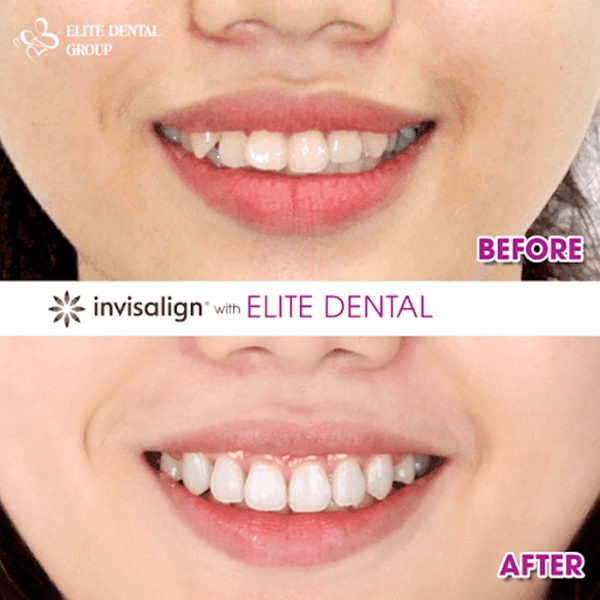Table of content
Did you know that achieving an attractive smile involves more than just a natural smile line? A properly aligned bite is crucial for not only aesthetics but also for optimal chewing function, long-term oral health, and the overall eating experience. So, what exactly is a proper bite? Let Elite Dental help you understand this important dental term in more detail!
1. What Constitutes a Proper Bite?
A proper bite is characterized by a harmonious and symmetrical alignment between the upper and lower jaws, as well as between the jaws and teeth.
The following criteria are used to assess a proper bite:
- Harmonious correlation with other facial features such as the eyes, nose, and forehead, creating an aesthetically pleasing appearance from both profile and front views.
- Balanced alignment between the upper and lower jaws. The upper front teeth should not cover more than 25% of the lower front teeth when the mouth is closed.
- Using a vertical axis that aligns with the midline between the two front teeth, the face should appear symmetrical without any deviation to the left or right.
- A proper bite ensures the face achieves the golden ratio, divided into three parts: from the hairline to the bridge of the nose, from the bridge of the nose to the base of the nose, and from the base of the nose to the chin.
- Individuals with a proper bite often have a sharp jawline without any coarseness.
Many people who’ve undergone orthodontic treatment notice more than just straighter teeth; braces can actually reshape the face, making it appear slimmer and more defined. But is this truly the case? Today, Elite Dental explores this question in depth. 1. Do Braces Change Your Face Shape? Braces work by gently…
In contrast, common bite misalignments include overbite, underbite, open bite, deep bite, and crossbite, each presenting with different symptoms.

2. Benefits of Having a Proper Bite
Having a proper bite offers numerous benefits:
- Stronger chewing force, improved eating efficiency, and enhanced taste sensation.
- Reduced risk of oral diseases and prevention of gastrointestinal issues.
- Lowered risk of jaw joint pain and temporomandibular joint (TMJ) disorders.
- Enhanced facial aesthetics, contributing to a more radiant smile.

3. How to Achieve an Ideal Bite
If you don’t currently have a proper bite, don’t worry. Advances in dentistry today can correct this issue through various methods.
3.1. Jaw Surgery
Surgery is typically applied in cases of severe bite misalignment caused by the jawbone. Depending on the severity of the misalignment, the doctor will develop an appropriate treatment plan.
Advantages:
- Corrects jaw misalignment and bite issues, improving facial appearance and chewing function.
- Quick procedure with long-lasting results.
Limitations:
- Higher costs compared to traditional orthodontics.
- This is a complex technique that requires skilled surgeons. If not performed correctly, it can lead to risks such as excessive bleeding, infection, nerve damage, which can be quite dangerous.
In practice, most patients with bite misalignment choose Orthodontics over surgery to ensure maximum safety.
3.2. Orthodontics
Orthodontics involves using specialized dental appliances to gradually move the teeth and jawbone into the correct position, resulting in a properly aligned bite and a balanced smile. The duration of orthodontic treatment can range from 2 to 2.5 years, depending on the patient.
Advantages:
- Helps achieve a physiologically correct bite, ensuring balance between the upper and lower jaws.
- Reasonably priced, accessible to most people.
- High aesthetic appeal, with the experience of wearing braces feeling almost invisible if you choose clear aligners.
- Preserves original teeth, maintains dental health in the long term.
Disadvantages:
- Metal braces can be cumbersome during eating and less aesthetic when communicating.
- Requires time and financial investment to ensure a smooth journey towards achieving an ideal bite.
Currently, there are two main orthodontic methods: traditional braces and clear aligners.
To know which orthodontic method is right for you, consult with an orthodontist for detailed advice.
For over 10 years, Elite Dental has proudly been a reputable dental center, helping hundreds of customers achieve ideal bite alignment and correcting all bite misalignment issues. Elite not only has a team of specialized, highly skilled orthodontists but also invests in modern equipment (such as 3D Trios dental scanning technology, Clincheck software, and Sirona X-ray machines from Germany) to provide maximum support throughout the customer’s orthodontic journey. Additionally, with a database of successful treatment cases, Elite dentists can show you cases similar to yours, helping you easily visualize the results after treatment and feel confident in starting your treatment.

4. Methods for Maintaining Proper Bite Alignment
Here are the recommendations from Elite Dental’s doctors that everyone should follow:
- Wear retainers after completing orthodontic treatment to keep the teeth in their new positions and allow new bone to form in harmony with the teeth’s new alignment.
- Brush your teeth thoroughly at least twice a day.
- Use saltwater or mouthwash to eliminate bacteria and bad breath.
- Attend follow-up appointments as scheduled.
- Avoid bad habits like resting your chin on your hand or chewing on one side only.
While having braces on your teeth, the teeth need extra care to protect them from tooth decay, staining and gum diseases. Also, you should take care to avoid damaging the braces. According to the Academy of General Dentistry, you should avoid these activities: eating chewy or sticky candy, eating hard…
If you have any further questions, please don’t hesitate to contact the doctors at Elite Dental for assistance. When you come to Elite Dental, you can be completely confident in the professional quality of care.
COSMETIC & ORTHODONTIC DENTISTRY CENTER
75 Huynh Tinh Cua, Ward Vo Thi Sau, District 3, HCMC
info@elitedental.com.vn
Hotline: (+84) 28 7306 3838 – (+84) 902661100
Related posts: > Understanding a Receding Chin: Signs, Causes, and Treatment Options > What causes crooked teeth, and can Invisalign help fix them? > Can Invisalign correct severely crowded teeth?









